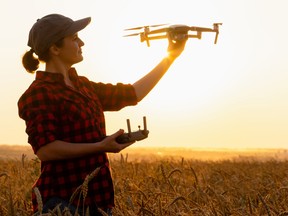Opinion: Not your grandpa's farm — how technology is advancing agriculture in Alberta

Article content
Kim McConnell
Alberta’s agricultural sector looks vastly different today compared with 50 years ago. Forget the stereotypical image of agriculture. It’s no longer your grandparents’ farm — there are no overalls, red barns or pitchforks.
Technology has transformed the way farms look, how they operate and the way farmers manage their crops, livestock, soil and grasslands. Today’s farms are high-tech and high-touch, and future innovation promises to bring even greater opportunity.
Innovation is the lifeblood of many industries and agriculture is no exception. For more than a century, Canadian research has developed new crops, pioneered new production, and designed and manufactured technologically advanced farm equipment. These innovations are sought after and adopted around the world.
Today, innovation in agtech is changing the face of agriculture. Technology advancements in precision agriculture, genomics, fertilizers and drones have already transformed Alberta’s agriculture industry: enhancing yields, quality and efficiency.
Precision agriculture uses tools such as yield monitors, GPS mapping and variable rate technology to precisely map and manage crop and soil data. This allows farmers to make informed decisions about fertilizer application, irrigation and planting to increase efficiency and productivity.
Advanced genomics and selected breeding are widely used in Alberta’s crops and livestock industry to enhance productivity, efficiency and nutrition.
Advancements in fertilizer technology are helping crop farmers reduce emissions. Precision application and 4R nutrient stewardship are changing how farmers apply fertilizer. Moreover, farmers are using new technology — such as smart fertilizers that adapt to crop and climate conditions — and fertilizers made from city waste, further contributing to sustainable agriculture.
Drones and robots are also being employed in agriculture to monitor fields — from assessing crop health and keeping an eye on livestock to detecting weeds and pests — and to replace tasks people used to do. For example, robots can milk cows, feed and water animals, and plant and harvest greenhouse crops.
But innovation doesn’t stop there. Numerous technological advancements are on the horizon.
Farmers are increasingly using artificial intelligence and machine learning to predict crop yields and identify areas of the field that are suffering from stress or disease. The internet connects farm equipment, sensors and accounting and traceability software, allowing farmers to make more accurate and profitable decisions.
Blockchain technology is being tested in agriculture to increase transparency and traceability in supply chains. This allows the agri-food industry to track their products from farm to table, providing consumers with information about the origin of their food and ensuring the integrity of food safety standards.
Advancements in processing will expand Alberta’s opportunity in value-added agriculture. The future will see the energy and agriculture sectors working together to produce biofuels from waste such as animal fats, off-grade canola and new-to-Alberta crops such as camelina.
These are just a few technologies that continue to transform Alberta’s agriculture industry.
Nevertheless, there are still significant barriers hindering agriculture from reaching its full potential. These include challenges related to regulatory approval, infrastructure development and investment attraction.
Regulatory approval is famously slow in Canada, and regulations differ between countries. This limits access to technology and tools, putting Albertan and Canadian agriculture at a disadvantage. Regulatory approvals at all levels of government should be more streamlined and efficient.
Also, infrastructure — specifically broadband capacity, rail transportation, and Port of Vancouver limitations — is a significant challenge that needs improvement. Alberta should consider assisting with projects that require substantial public investments, as the benefits that flow from them will support agriculture and other industries in the province.
Finally, attracting investment is a third challenge, particularly in the $20-million to $100-million range needed to move commodity products up the value chain in areas including value-added processing. Alberta should continue in its effort to make the province an attractive location for investment and growth.
By addressing these barriers, Alberta’s agriculture industry can realize the full opportunity of technology.
Kim McConnell is a Canadian agriculture expert and a contributor to the Business Council of Alberta. This column is part of a discussion paper series by the business council called Missions and Moonshots, which explores how Alberta can reach its full potential in three key areas of the economy: food, health and energy.






Postmedia is committed to maintaining a lively but civil forum for discussion. Please keep comments relevant and respectful. Comments may take up to an hour to appear on the site. You will receive an email if there is a reply to your comment, an update to a thread you follow or if a user you follow comments. Visit our Community Guidelines for more information.